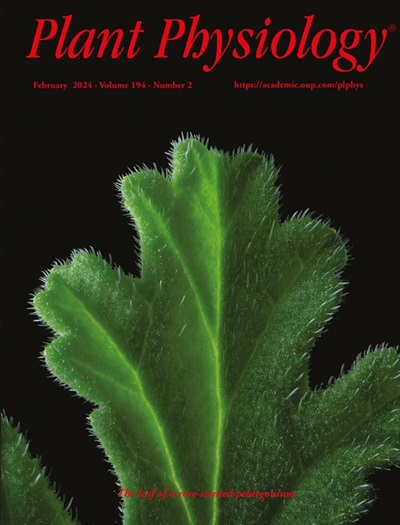A galactolipase activated by high light helps cells acclimate to stress in cyanobacteria
IF 6.5
1区 生物学
Q1 PLANT SCIENCES
引用次数: 0
Abstract
In the cyanobacterium Synechococcus elongatus PCC 7942, high-light (HL) stress activates deacylation of the four major lipid classes in the membrane. To investigate the mechanism and the physiological relevance of the HL-activated lipid deacylation, we searched for lipase genes of S. elongatus by measuring in vitro lipase activity of recombinant proteins expressed in Escherichia coli. Three genes (lipB, lipC, and lipD) were identified as lipase genes out of 14 candidates, and lipB was found to be conserved in most cyanobacteria. His-tagged LipB protein showed acyl-hydrolyzing activity against galactolipids in vitro. In a strain deficient in acyl-acyl carrier protein synthetase and hence defective in the recycling of free fatty acids (FFA), HL-induced accumulation of FFA and lysogalactolipids was reduced by 45% by lipB inactivation, verifying that LipB is a lipase involved in the HL-induced deacylation of galactolipids. Deficiency of lipB in the WT background had no impact on PSII photoinhibition or its subsequent recovery; however, unlike WT cells, ΔlipB cells failed to quickly resume growth when irradiated with strong light (2,000 µmol photons m-2 s-1). The HL sensitivity of growth due to lipB deficiency was more pronounced under nitrogen-limiting conditions. The phenotype was rescued by wild-type LipB expression but not by inactive LipB variant expression. These results suggest that the deacylation of galactolipids by LipB helps cells acclimate to HL conditions by regulating factors other than PSII activity.高光激活的半乳糖酶帮助细胞适应蓝藻中的压力
在蓝藻长聚球菌PCC 7942中,高光(HL)胁迫激活了膜上四种主要脂类的去酰化。为了研究hl激活的脂质去酰化的机制和生理相关性,我们通过测定大肠杆菌中表达的重组蛋白的脂肪酶活性,寻找延长葡萄球菌的脂肪酶基因。在14个候选基因中,有3个基因(lipB、lipC和lipD)被鉴定为脂肪酶基因,并且lipB在大多数蓝藻中被发现是保守的。他标记的LipB蛋白在体外对半乳糖脂具有酰基水解活性。在一个缺乏酰基酰基载体蛋白合成酶的菌株中,由于游离脂肪酸(FFA)的再循环缺陷,hl诱导的FFA和溶半乳糖脂的积累通过lipB失活减少了45%,证实lipB是一种参与hl诱导的半乳糖脂去酰化的脂肪酶。WT背景下lipB的缺乏对PSII光抑制及其随后的恢复没有影响;然而,与WT细胞不同的是,ΔlipB细胞在强光(2000µmol光子m-2 s-1)照射下不能快速恢复生长。lipB缺乏对生长的HL敏感性在限氮条件下更为明显。野生型LipB的表达挽救了表型,而非非活性LipB变体的表达挽救了表型。这些结果表明,LipB对半乳糖脂的去酰化作用通过调节PSII活性以外的其他因素帮助细胞适应HL条件。
本文章由计算机程序翻译,如有差异,请以英文原文为准。
求助全文
约1分钟内获得全文
求助全文
来源期刊

Plant Physiology
生物-植物科学
CiteScore
12.20
自引率
5.40%
发文量
535
审稿时长
2.3 months
期刊介绍:
Plant Physiology® is a distinguished and highly respected journal with a rich history dating back to its establishment in 1926. It stands as a leading international publication in the field of plant biology, covering a comprehensive range of topics from the molecular and structural aspects of plant life to systems biology and ecophysiology. Recognized as the most highly cited journal in plant sciences, Plant Physiology® is a testament to its commitment to excellence and the dissemination of groundbreaking research.
As the official publication of the American Society of Plant Biologists, Plant Physiology® upholds rigorous peer-review standards, ensuring that the scientific community receives the highest quality research. The journal releases 12 issues annually, providing a steady stream of new findings and insights to its readership.
 求助内容:
求助内容: 应助结果提醒方式:
应助结果提醒方式:


